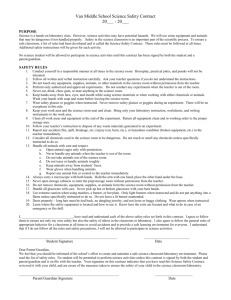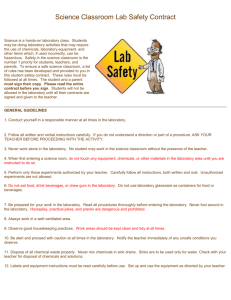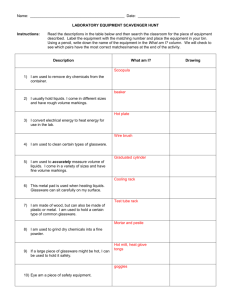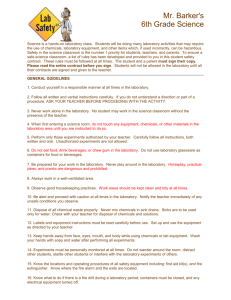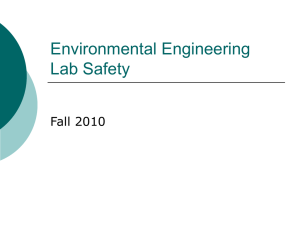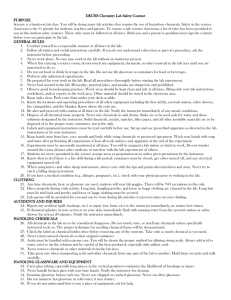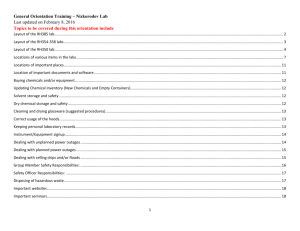6th Grade Science Lab Safety Agreement & Rules
advertisement
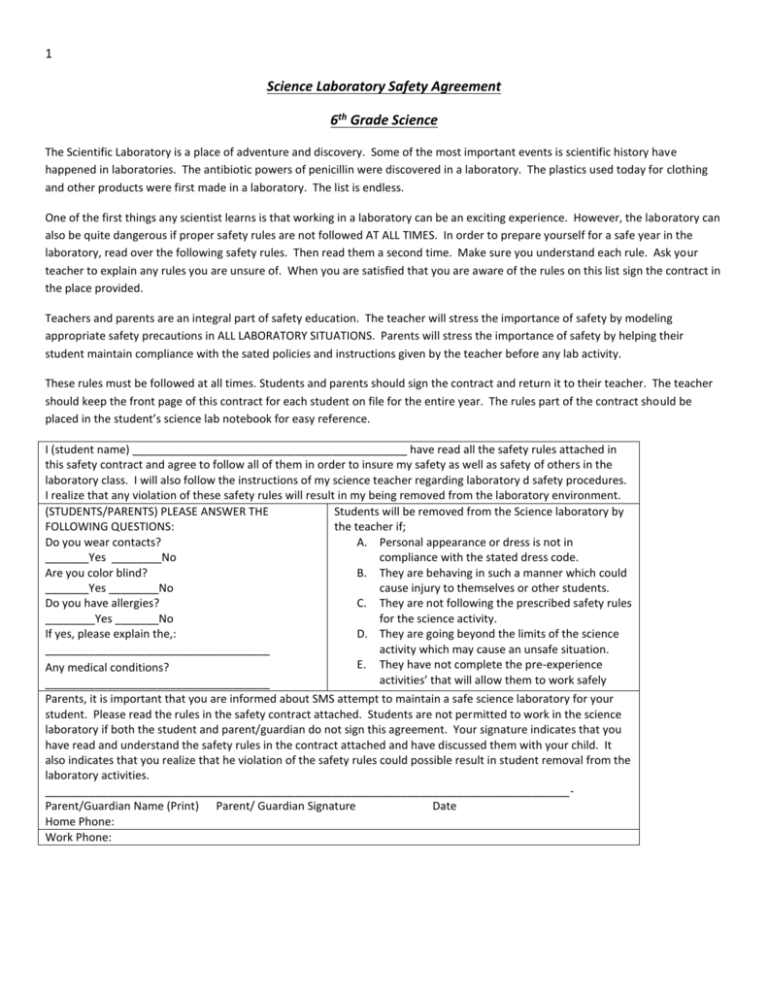
1 Science Laboratory Safety Agreement 6th Grade Science The Scientific Laboratory is a place of adventure and discovery. Some of the most important events is scientific history have happened in laboratories. The antibiotic powers of penicillin were discovered in a laboratory. The plastics used today for clothing and other products were first made in a laboratory. The list is endless. One of the first things any scientist learns is that working in a laboratory can be an exciting experience. However, the laboratory can also be quite dangerous if proper safety rules are not followed AT ALL TIMES. In order to prepare yourself for a safe year in the laboratory, read over the following safety rules. Then read them a second time. Make sure you understand each rule. Ask your teacher to explain any rules you are unsure of. When you are satisfied that you are aware of the rules on this list sign the contract in the place provided. Teachers and parents are an integral part of safety education. The teacher will stress the importance of safety by modeling appropriate safety precautions in ALL LABORATORY SITUATIONS. Parents will stress the importance of safety by helping their student maintain compliance with the sated policies and instructions given by the teacher before any lab activity. These rules must be followed at all times. Students and parents should sign the contract and return it to their teacher. The teacher should keep the front page of this contract for each student on file for the entire year. The rules part of the contract should be placed in the student’s science lab notebook for easy reference. I (student name) ____________________________________________ have read all the safety rules attached in this safety contract and agree to follow all of them in order to insure my safety as well as safety of others in the laboratory class. I will also follow the instructions of my science teacher regarding laboratory d safety procedures. I realize that any violation of these safety rules will result in my being removed from the laboratory environment. (STUDENTS/PARENTS) PLEASE ANSWER THE Students will be removed from the Science laboratory by FOLLOWING QUESTIONS: the teacher if; Do you wear contacts? A. Personal appearance or dress is not in _______Yes ________No compliance with the stated dress code. Are you color blind? B. They are behaving in such a manner which could _______Yes ________No cause injury to themselves or other students. Do you have allergies? C. They are not following the prescribed safety rules ________Yes _______No for the science activity. If yes, please explain the,: D. They are going beyond the limits of the science activity which may cause an unsafe situation. ____________________________________ E. They have not complete the pre-experience Any medical conditions? activities’ that will allow them to work safely ____________________________________ Parents, it is important that you are informed about SMS attempt to maintain a safe science laboratory for your student. Please read the rules in the safety contract attached. Students are not permitted to work in the science laboratory if both the student and parent/guardian do not sign this agreement. Your signature indicates that you have read and understand the safety rules in the contract attached and have discussed them with your child. It also indicates that you realize that he violation of the safety rules could possible result in student removal from the laboratory activities. ____________________________________________________________________________________Parent/Guardian Name (Print) Parent/ Guardian Signature Date Home Phone: Work Phone: 2 Science Laboratory Safety Agreement 6th Grade Science PLEASE NOTE: These are general safety rules for any science classroom. Some of these rules may not apply to the level of instruction that your child will received this school year while others may be added as necessary for the science discipline that the students is taking for that year. GENERAL GUIDELINES: 1. Personal Protective Equipment Many materials in the lab can cause eye injury. ALWAYS WEAR APPROVED SAFETY GOGGLES. 2. PROPER DRESS is a necessity. Long hair, dangling jewelry, loose and baggy clothing are hazardous in the lab. Long hair must be tied back, dangling jewelry must be removed and loose clothing should be removed or secured. No sandals are allowed in the lab, shoes must cover the entire foot. Long pants (skirts of mid calf length) should be worn when using hazardous chemicals or heated substance. (No shorts, no skirts above the knee). Fingernails of extreme length WILL NOT BE ALLOWED in the lab. Synthetic fingernails are very flammable. Makeup and hair spray may NEVER be applied in lab area. 3. Responsible conduct is expected at all times in the lab. Horseplay, loud talking, joking and pranks are dangerous and not allowed in the lab. 4. DO NOT TOUCH lab equipment, chemicals, or materials until you are instructed to do so or have been given permission to do so 5. Read all lab procedures carefully and thoroughly before attempting the lab. Listen alertly at the Pre-lab briefing. Follow the directions exactly as they are written. 6. Follow oral and written directions explicitly. If you do not understand any part of a procedure, ask your instructor to explain it to you. . 7. 8. 9. 10. 11. 12. 13. Never work alone in a lab. A science teacher must be present during laboratory experiences. Never eat, drink or chew gum in the lab. Perform only teacher authorized activities Keep your workplace clean and clear of purses, books, jackets, etc. Take only your lab report to the area. Know the location and how to use all of the safety equipment (goggles, aprons, eyewash, fore blanket, fire extinguishers, first aid kit, fire alarm, emergency phone, which teacher to go to for help) Contact the teacher immediately if you spill any material or see any unsafe activity Dispose of all chemicals as instructed in the pre-lab procedure. Never pour chemicals down the sink. Never dispose of solid materials in the sink; place them is waste containers provided by the teacher . 14. Work in ventilated areas. Do not place your head under the fume hood. 15. Keep the lab aisles clear. Stools should be placed under the desks when they are not being used. 16. Read all directions and labels carefully. Set up equipment as instructed by your teacher 17. Do not move around the lab Stay at your station and monitor your experiment so other students are not disturbed. 18. No students are to be allowed access to the science storeroom unless specific permission has been given. 19. Know what to do if a fire drill occurs during the period. 20. All living and preserved organisms should be handled in a humane manner. Handle and dispose of preserved materials as instructed by your teacher. 21. Wash your hands after working in the lab. Keep your hands away from your face, eyes, mouth and body during lab experiences especially if you are using chemicals. After lab, clean your work area and return all equipment clean. . 22. Handle scalpels or razor blades with extreme care. Never cut materials towards you: always cut away from you. Hold sharp instruments by their handle. Properly mount dissecting specimens to the dissecting pan before making a cut 23. Contact lenses are a hazard in the science laboratory. They should not be worn in the lab unless you have permission from your doctor. 24. Never touch, taste, or smell any chemical. Many chemicals are poisonous. To note the fumes in an experiment, gently wave your hand over the opening of the container and direct the fumes toward your nose. Do not inhale the fumes directly. 25. Move acids from one place to another with great care. Pour acids and bases over the sink rather than the lab bench. 3 Science Laboratory Safety Agreement 6th Grade Science 47. Never leave a flame unattended. Turn the burner off when not in use. 26. Read all chemical labels twice. Only remove what you need for the experiment. 37. Turn off all power when setting up electrical equipment 27. Do not return excess chemicals to the stock reagent bottle. This will contaminate the bottle. Always use different spatula for different chemicals. 38. Never eat to drink form laboratory glassware. Clean glassware before putting it away. 48. Always point a test tube that is being heated away from you and others. Move the test tube while heating, rather than holding it still. 39. When disconnecting a piece of electrical equipment pull the plug and not the wire. Hands should be dry before touching an electrical outlet, plug, or switch. 49. Always use a clamp or tongs when handling hot containers. HOT glassware looks the same as cold glassware. Set it aside and check the heat by putting the back of your hand near it. 40. Batteries should never be intentionally shorted. The heat generated in a bare copper wire paced directly across the battery terminals can causes severe burns, If a mercury dry cell is shorted an explosion can occur. 50. Never look into a container that is being heated. 41. Never deliberately shock yourself or another person. Never put any object in an electrical outlet. Susceptibility to shock and the possible resulting injury is unpredictable. End of Experiment Rules 28. Use a pipette bulb. solutions using your mouth Never pipette 29. To transfer reagents from one bottle to another, pour away from you body. Your teacher will demonstrate proper procedure for removing the stopper form the reagent bottle and how to hold it while pouring the liquid. Never interchange stoppers from two different containers. 30. Handle acids with care. When diluting an acid, always pour the acid into water. 31. Keep all flammable liquids away from open flames. HANDLING GLASSWARE AND EQUIPMENT 32. Never remove chemicals or lab materials from the laboratory33. Carry glass tubing and glassware in a vertical position 34. Never handle broken glassware with bare hands. Inform your teacher and dispose of broken glassware as instructed. 35. Glass tubing will not be inserted into rubber stoppers by students. Teachers or lab managers will insert glass tubing into rubber stoppers by using a lubricant and protecting hands with paper towels, instructors will remove “frozen: glassware. 36. Wash bottles are only for the purpose intended. (rinsing glassware equipment, adding water) Fill them only with distilled water. 42. Examine all glassware before use. Never use chipped, cracked or broken glassware for heating. Be sure all glassware is clean and dry. 43. Notify your teacher of damaged laboratory equipment immediately. Look for frayed cords, exposed wires, chips, cracks, etc. Never use damaged electrical equipment. 44. If you are not familiar with a piece of equipment, ask the teacher for help. 45. Do not place hot glassware in cold water, it may shatter. 46. Use care when using a gas burner. Clothing and hair should be away from the flame, never reach over an open flame; use safety goggles. Light burners as instructed by the teacher. 51. Place heated containers on an insulated pad. Never place a hot container on the lab desk. 52. Always clean your work area and return equipment to its proper place. 53. Wash your hands after every lab experience. 54. Make sure all candles and burners are turned off before leaving the lab. Accidents and injuries: Report any accident (spill, break, etc) or injury (cut, burn, etc.) to the teacher immediately, even if it seems insignificant. If anyone is hurt yell out “Code One, Code One” to get your teachers attention. If chemicals get splashed in your eyes or skin, begin to rinse with running water from the safety shower or eyewash station for at least 20 minutes. Notify your teacher immediately. If a mercury thermometer is broken – notify the teacher immediately. Mercury can only be cleaned with a Mercury spill kit

